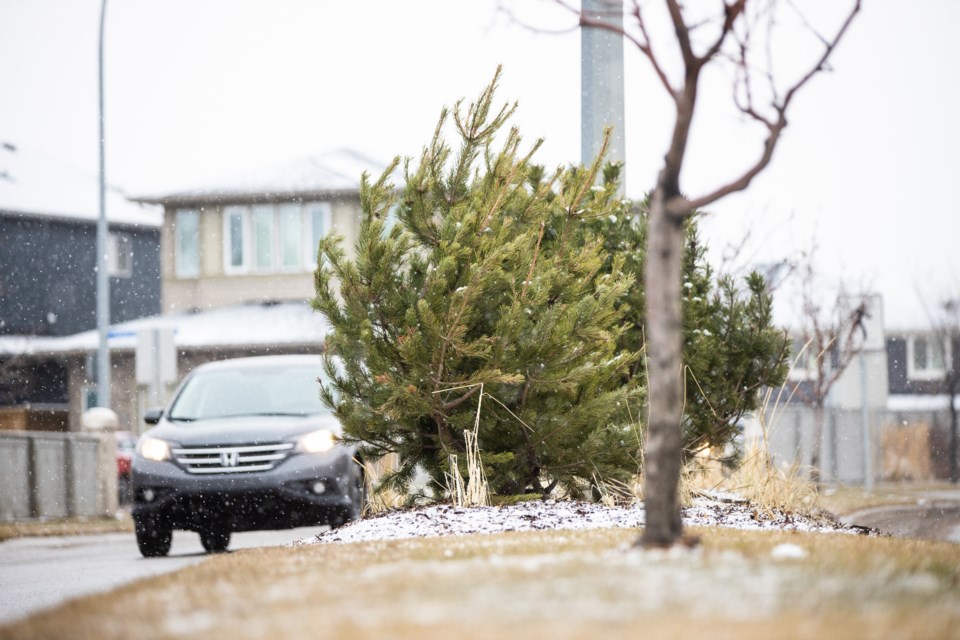Two new groves of trees erected in Cimarron are expected to slow traffic on one of the town’s busiest roads.
Drivers and residents have voiced concerns over traffic on Cimarron Boulevard for several years, with many people using the street as a corridor between Southbank and Cornerstone shopping areas.
The Town’s latest traffic-calming method on the road was to plant several bushy trees at the east and west ends of the street. Okotoks engineering manager Rob Dickinson said it’s been done in many other municipalities to purposely reduce sightlines and effectively narrow the road.
“When nobody’s parked along that road your sightline is so far and the road appears so open that people just generally speed to the point they feel they’re comfortable,” said Dickinson. “In that instance, you can drive fairly fast and still see so far that you’ll actually end up speeding and you won’t even realize it.”
Planting bushier trees that grow out to the curb line create the perception the road is being pinched without actually changing its construction, he said.
It’s similar to when cars are parked along both sides of the road, he said – people naturally drive slower because it feels less comfortable to speed.
The locations were chosen as a result of traffic studies that showed drivers sped most often at the two entrances to Cimarron Blvd., he said.
“We wanted to have it as close as possible to the locations where people are actually speeding, as well as somewhere where we weren’t impacting sightlines and somewhere where the neighbourhood would be more receptive to it being there,” said Dickinson.
The neighbours weren’t too keen on trees at the east end to begin with. Sightlines had been more impacted than initially thought, particularly for residents in the condos at Cimarron Vista Gardens, he said.
Though the trees met traffic standards, Dickinson said the Town erred on the side of caution and removed some of the plants to re-establish sightlines in the area.
Planting trees was one of the more cost-effective traffic calming methods the Town could undertake this year, said Dickinson. In conjunction with work done over the last two years, he said the Town hopes the project will help alleviate some of the issues with speeding vehicles.
He said additional speed limit signs have been erected along the boulevard, and the Town uses vehicle-activated speed signs that flash when someone is travelling over the speed limit.
“We move those around, because if you leave them in one place too long they become ineffective,” said Dickinson. “People stop seeing them and reacting.”
When they aren’t moved, sometimes they are used in silent mode to track vehicle speeds and volumes as a means of research, he said.
There has also been more enforcement along Cimarron Blvd., and the Town modified some of the curbs at pedestrian crossings to narrow the roadway, which slows drivers down, he said.
One thing the Town has not done yet is install traffic signals, he said. A traffic study done in 2016 recommended a set of lights along Cimarron Blvd. in the next 15 to 20 years.
“The engineer who did the study advised we could install them sooner, they would break up the traffic and slow people down, but they’re not warranted for 15 to 20 years and they do add time to people travelling that corridor,” said Dickinson. “When we went out to the community they’re weren’t in favour of installing those just because of the interruption to the people in the meantime.”
He said the full build-out of Cimarron and the Southbank commercial area at 32 Street, as well as development of Wind Walk and Gold Metal areas at Southridge Drive and Highway 7, will result in a need for traffic lights on Cimarron Blvd.
In the meantime, the Town will continue to monitor the road, paying specific attention to the locations of the new trees to see whether they’re working as intended, he said.
“If it’s not effective then obviously it’s not the right treatment for this road,” said Dickinson.




